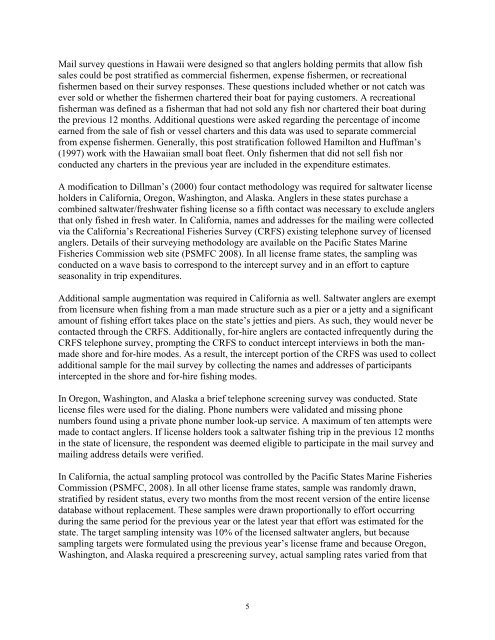The Economic Contribution of Marine Angler Expenditures in the ...
The Economic Contribution of Marine Angler Expenditures in the ...
The Economic Contribution of Marine Angler Expenditures in the ...
Create successful ePaper yourself
Turn your PDF publications into a flip-book with our unique Google optimized e-Paper software.
Mail survey questions <strong>in</strong> Hawaii were designed so that anglers hold<strong>in</strong>g permits that allow fish<br />
sales could be post stratified as commercial fishermen, expense fishermen, or recreational<br />
fishermen based on <strong>the</strong>ir survey responses. <strong>The</strong>se questions <strong>in</strong>cluded whe<strong>the</strong>r or not catch was<br />
ever sold or whe<strong>the</strong>r <strong>the</strong> fishermen chartered <strong>the</strong>ir boat for pay<strong>in</strong>g customers. A recreational<br />
fisherman was def<strong>in</strong>ed as a fisherman that had not sold any fish nor chartered <strong>the</strong>ir boat dur<strong>in</strong>g<br />
<strong>the</strong> previous 12 months. Additional questions were asked regard<strong>in</strong>g <strong>the</strong> percentage <strong>of</strong> <strong>in</strong>come<br />
earned from <strong>the</strong> sale <strong>of</strong> fish or vessel charters and this data was used to separate commercial<br />
from expense fishermen. Generally, this post stratification followed Hamilton and Huffman’s<br />
(1997) work with <strong>the</strong> Hawaiian small boat fleet. Only fishermen that did not sell fish nor<br />
conducted any charters <strong>in</strong> <strong>the</strong> previous year are <strong>in</strong>cluded <strong>in</strong> <strong>the</strong> expenditure estimates.<br />
A modification to Dillman’s (2000) four contact methodology was required for saltwater license<br />
holders <strong>in</strong> California, Oregon, Wash<strong>in</strong>gton, and Alaska. <strong>Angler</strong>s <strong>in</strong> <strong>the</strong>se states purchase a<br />
comb<strong>in</strong>ed saltwater/freshwater fish<strong>in</strong>g license so a fifth contact was necessary to exclude anglers<br />
that only fished <strong>in</strong> fresh water. In California, names and addresses for <strong>the</strong> mail<strong>in</strong>g were collected<br />
via <strong>the</strong> California’s Recreational Fisheries Survey (CRFS) exist<strong>in</strong>g telephone survey <strong>of</strong> licensed<br />
anglers. Details <strong>of</strong> <strong>the</strong>ir survey<strong>in</strong>g methodology are available on <strong>the</strong> Pacific States <strong>Mar<strong>in</strong>e</strong><br />
Fisheries Commission web site (PSMFC 2008). In all license frame states, <strong>the</strong> sampl<strong>in</strong>g was<br />
conducted on a wave basis to correspond to <strong>the</strong> <strong>in</strong>tercept survey and <strong>in</strong> an effort to capture<br />
seasonality <strong>in</strong> trip expenditures.<br />
Additional sample augmentation was required <strong>in</strong> California as well. Saltwater anglers are exempt<br />
from licensure when fish<strong>in</strong>g from a man made structure such as a pier or a jetty and a significant<br />
amount <strong>of</strong> fish<strong>in</strong>g effort takes place on <strong>the</strong> state’s jetties and piers. As such, <strong>the</strong>y would never be<br />
contacted through <strong>the</strong> CRFS. Additionally, for-hire anglers are contacted <strong>in</strong>frequently dur<strong>in</strong>g <strong>the</strong><br />
CRFS telephone survey, prompt<strong>in</strong>g <strong>the</strong> CRFS to conduct <strong>in</strong>tercept <strong>in</strong>terviews <strong>in</strong> both <strong>the</strong> manmade<br />
shore and for-hire modes. As a result, <strong>the</strong> <strong>in</strong>tercept portion <strong>of</strong> <strong>the</strong> CRFS was used to collect<br />
additional sample for <strong>the</strong> mail survey by collect<strong>in</strong>g <strong>the</strong> names and addresses <strong>of</strong> participants<br />
<strong>in</strong>tercepted <strong>in</strong> <strong>the</strong> shore and for-hire fish<strong>in</strong>g modes.<br />
In Oregon, Wash<strong>in</strong>gton, and Alaska a brief telephone screen<strong>in</strong>g survey was conducted. State<br />
license files were used for <strong>the</strong> dial<strong>in</strong>g. Phone numbers were validated and miss<strong>in</strong>g phone<br />
numbers found us<strong>in</strong>g a private phone number look-up service. A maximum <strong>of</strong> ten attempts were<br />
made to contact anglers. If license holders took a saltwater fish<strong>in</strong>g trip <strong>in</strong> <strong>the</strong> previous 12 months<br />
<strong>in</strong> <strong>the</strong> state <strong>of</strong> licensure, <strong>the</strong> respondent was deemed eligible to participate <strong>in</strong> <strong>the</strong> mail survey and<br />
mail<strong>in</strong>g address details were verified.<br />
In California, <strong>the</strong> actual sampl<strong>in</strong>g protocol was controlled by <strong>the</strong> Pacific States <strong>Mar<strong>in</strong>e</strong> Fisheries<br />
Commission (PSMFC, 2008). In all o<strong>the</strong>r license frame states, sample was randomly drawn,<br />
stratified by resident status, every two months from <strong>the</strong> most recent version <strong>of</strong> <strong>the</strong> entire license<br />
database without replacement. <strong>The</strong>se samples were drawn proportionally to effort occurr<strong>in</strong>g<br />
dur<strong>in</strong>g <strong>the</strong> same period for <strong>the</strong> previous year or <strong>the</strong> latest year that effort was estimated for <strong>the</strong><br />
state. <strong>The</strong> target sampl<strong>in</strong>g <strong>in</strong>tensity was 10% <strong>of</strong> <strong>the</strong> licensed saltwater anglers, but because<br />
sampl<strong>in</strong>g targets were formulated us<strong>in</strong>g <strong>the</strong> previous year’s license frame and because Oregon,<br />
Wash<strong>in</strong>gton, and Alaska required a prescreen<strong>in</strong>g survey, actual sampl<strong>in</strong>g rates varied from that<br />
5
















